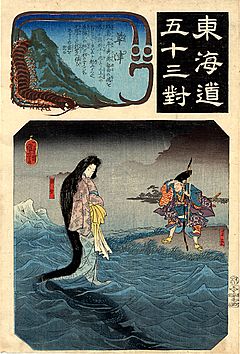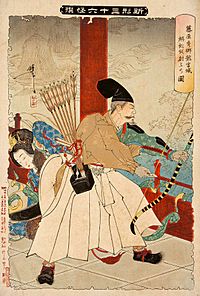Tawara Tōda Monogatari facts for kids


The Tale of Tawara Tōda (俵藤太物語, Tawara Tōda monogatari) is a Japanese heroic tale recounting the legendary exploits of Fujiwara no Hidesato. It is part of the otogi-zōshi genre of tales dating to the Edo Period or earlier. Some of the fabulous accounts are also told in the military pseudo-chronicle, Taiheiki (14th century).
He used bow and arrow to kill a giant centipede (mukade) which wrapped around a mountain near Lake Biwa, fulfilling the request of a serpent at a bridge, which turned out to be a court lady (or Dragon King) from the underwater Ryūgū-jō (龍宮城) "Dragon Palace". The hero was entertained at the palace and received rewards including armor and sword, and an inexhaustible bag of rice.
"My Lord Bag-O'-Rice" is English-translated title of Basil Hall Chamberlain's retelling, published as a fairy tale (1887). This was later followed by Yei Theodora Ozaki's translation "My Lord Bag of Rice" (1903) based on Iwaya Sazanami's retelling.
Setting
The story is set in Ōmi Province (Shiga Prefecture), and begins with a large serpent lying on Seta Bridge on the brink of Lake Biwa. The serpent, which later assumes human form, conveys Hidesato to the Dragon Palace, which can be reached through the depths of this Lake.
There is a Shinto shrine near the Seta Bridge at Lake Biwa where people have venerated Tawara Tōda.
Figure
Tawara Tōda 俵藤太 "Rice-bag Tōda", a pun between tawara "straw rice-bag; straw barrel" and the Japanese name or place name 田原 (Tawara), was the nickname given to the historical Fujiwara no Hidesato who flourished in the first half of the 10th century and participated in the suppression of the rebel usurper Taira no Masakado.
The nickname is sometimes styled "Tawara [no] Tōta".
Summary
The hero's centipede-slaying legend as contained in the Tawara Tōda monogatari ("The Tale of Tawara Tōda") was widely circulated and read during the early Edo Period (17th century), when the text was being copied in picture scrolls (emaki) and appearing in Otogizōshi type woodblock-printed (and hand-copied) books. A summary of the monogatari version is as follows:
The monogatari version probably derives from earlier accounts of Hidesato's centipede slaying described in the 14th-century Taiheiki, expanded with layers of legendary and religious (Buddhist) motifs. The above summary is not the entirety of Tawara Tōda monogatari, which contains a second part where the hero triumphs over Taira no Masakado, despite the latter having an iron body which was invulnerable except at the temples on his head, and having six ghostly doubles of himself.
Taiheiki version
The 14th-century Taiheiki records a much earlier version of this legend about Hidesato, but instead of the dragon turning into a beautiful woman, it transforms into a "strange small man" – the Dragon King himself. And here, Hidesato is invited to the Dragon Palace first and thereafter combats the centipede that attacks the aquatic realm. Here the inexhaustible silk and rice bag are received from the Dragon King, but not the copper alloy pan/pot, only the copper temple-bell.
Other attestations
A version (similar to the monogatari) appears in Honchō kaidan koji (本朝怪談故事) (1711) as pointed out by Dutch Japanologist Marinus Willem de Visser.
The centipede coiled seven and a half turns around Mount Mikami according to popular tradition. An early written mention of this occurs in the area guidebook Ōmi yochi shiryaku (1723).
The name Chikushi (遅来矢) has been ascribed to the sword given by the Dragon King in the Wakan sansai zue encyclopedia (1712) and the Tōkaidō meisho zue almanac (1797).
Hidesato's alleged armor from the Dragon Palace bore the similarly scripted name Hiraishi (避来矢) according to the Ujisatoki (before 1713). Hiraishi (平石), an armor with the same-sounding but differently written name, is listed as a gift of Dragon Palace in Arai Hakuseki's Honchō gunkikō (1709); this work mentions a second armor Muromaru (室丸) being obtained as well.
Although not an attestation of the entire story, a sword named Mukadegiri (蚣切) "Centepede-cutter" purportedly owned by Hidesato according to the inscription borne on its tang was bequeathed to the Ise Shrine. The Ise Shrine (Chōkokan Museum) also houses a kenuki gata or "tweezer type" that allegedly belonged to Hidesato.
Fairy tale translations
An English version of the tale entitled "My Lord Bag-O'-Rice" (1887) was translated by Basil Hall Chamberlain, and published as Japanese Fairy Tale Series No. 15 by Hasegawa Takejirō.
An otogibanashi (Japanese fairy tale) version entitled ”Tawara Tōda" (「俵藤太」), retold by Iwaya Sazanami appeared in the 1890s. Subsequently, "My Lord Bag of Rice" was included in Japanese Fairy Tales (1903) anthologized by Yei Theodora Ozaki. Ozaki's version is a retelling based on the rendition by "Sadanami sanjin", the misspelled alias of Iwaya Sazanami. Ozaki's book was illustrated by Kakuzō Fujiyama.
"My Lord Bag of Rice" is also found in A Book of Dragons (1965) by Ruth Manning-Sanders, illustrated by Robin Jacques.

